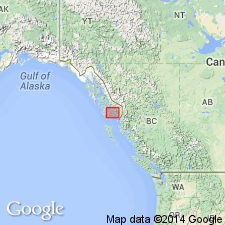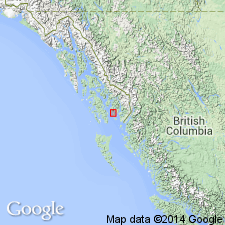
- Usage in publication:
-
- Vallenar series*
- Modifications:
-
- Named
- Biostratigraphic dating
- Dominant lithology:
-
- Limestone
- Schist
- Slate
- AAPG geologic province:
-
- Alaska Southeastern region
Summary:
Named for Vallenar Bay at northern end of Gravina Island, southeastern AK, designated as its type exposures [locality]. Has been mapped as broad belt on western side of island but positively identified only at Vallenar Bay. Composed essentially of limestones and calcareous schists with some black slates. Underlies Gravina series (new). Relations to Ketchikan series (new) is undetermined. Age in part is determined by fossils of Middle Devonian age identified by Charles Schuchert.
Source: GNU records (USGS DDS-6; Menlo GNULEX).

- Usage in publication:
-
- Vallenar formation*
- Modifications:
-
- Revised
- Areal extent
- AAPG geologic province:
-
- Alaska Southeastern region
Summary:
Vallenar "series" of Brooks (1902) is revised to Vallenar formation and restricted to its type area because only this part of "series" is of Middle Devonian age. [Geologic sketch map shows rocks formerly part of Brooks (1902) Vallenar "series" are unnamed units --one of Triassic age and one of Jurassic or Cretaceous age.]
Source: GNU records (USGS DDS-6; Menlo GNULEX).
For more information, please contact Nancy Stamm, Geologic Names Committee Secretary.
Asterisk (*) indicates published by U.S. Geological Survey authors.
"No current usage" (†) implies that a name has been abandoned or has fallen into disuse. Former usage and, if known, replacement name given in parentheses ( ).
Slash (/) indicates name conflicts with nomenclatural guidelines (CSN, 1933; ACSN, 1961, 1970; NACSN, 1983, 2005, 2021). May be explained within brackets ([ ]).

